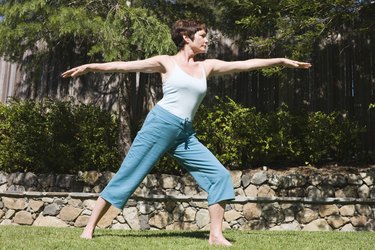
Since you hit age 45, you may be having a harder time keeping off weight. According to the Centers for Disease Control and Prevention, women over age 45 weigh 20 to 25 pounds more than they did in their 20s. The struggle with your weight may be due to a few factors, including activity, food choices and hormones. While you may not have much control over your hormones, you can gain control over your weight with more activity and a change in your eating habits. Consult your doctor before starting any weight-loss and exercise plan.
Cutting Calories to Lose Weight
Video of the Day
According to the American Council on Exercise, your metabolism decreases by 1 to 2 percent every decade, which means you have to eat 300 fewer calories now than you did in your 20s to maintain the same weight. To lose weight, you need to cut back even more, by 500 calories to 1,000 calories a day, to lose 1 pound to 2 pounds a week. You can determine your weight-loss calories by first tracking what you normally eat and then subtracting 500 calories to 1,000 calories from that number. For example, if you currently eat 2,200 calories a day, to lose 1 pound a week, you need to limit your intake to 1,700 calories a day.
Video of the Day
In general, women 45 years and older can lose weight by limiting their intake to 1,200 calories to 1,500 calories, and they may even be able to eat a little more, depending on activity level, according to the National Heart, Lung and Blood Institute. Eating too few calories may impair your ability to meet your vitamin and mineral needs, so don't limit your intake to fewer than 800 calories unless directed to do so by your physician.
Healthy Food Choices for Women Over 45
In addition to restricting your calorie intake, make sure you include the right foods. The Academy of Nutrition and Dietetics advises that starting in their 40s, women need to eat a diet that's rich in nutrients to help fight the battle of the bulge and also provide the nutrients necessary to delay the aging process. AND recommends you start by ensuring you get 2 cups of fruit and 2 1/2 cups of vegetables a day. Bone health is important for women 45 and over, so don't skimp on foods rich in calcium, such as milk, yogurt, leafy greens and tofu, as well as vitamin D-rich foods, such as fortified milk, eggs and salmon. Round out your diet with more whole grains for fiber and healthy sources of protein such as poultry, lean red meat, eggs, soy foods and beans.
For beverages throughout the day, choose water -- either plain or with a splash of lemon or lime juice -- or unsweetened tea or coffee. Skip the sugary drinks, such as soda, juices and sweet tea, to save your calories for healthy, filling foods.
Sample Meal Plan for Weight Loss
To prevent bouts of extreme hunger that can lead to overeating, enjoy regular meals and don't skip breakfast. Start your day right with a bone-building, weight-reducing breakfast that includes a 6-ounce container of nonfat yogurt with 1 cup of oatmeal topped with 1 cup of sliced strawberries and 6 chopped pecan halves. At lunch, meet some of your daily veggie needs with 1 1/2 cups of mixed greens topped with 3 ounces of sliced chicken breast, 1 ounce of shredded low-fat cheese and 2 tablespoons of balsamic vinaigrette with five whole-grain crackers and a medium banana. For dinner, you might enjoy 1 cup of whole-wheat lo-mein noodles tossed with 1 cup of mixed veggies, 1/2 cup of cubed firm tofu, and a sauce of 2 teaspoons of peanut butter blended with low-sodium soy sauce. Don't forget a healthy snack such as 3/4 cup of unsweetened whole-grain cereal with 1 cup of nonfat milk. This sample daily meal plan has about 1,400 calories.
Exercise for Women 45 and Over
Fight off some of the effects of your declining metabolism by adding exercise to your daily routine. You can start with a 30-minute brisk walk or bike ride five days a week and slowly build up your intensity as your fitness level improves.
In addition to aerobic exercise, include strength-training exercises two or more days a week to improve muscle mass, which might also give your metabolism a boost, because muscle tissue burns more calories than fat. Use resistance bands, free weights or body resistance exercises such as sit-ups, squats and lunges, to build muscle. If you're unsure how to begin, you may want to consult a personal trainer or invest in an exercise DVD.
- Centers for Disease Control and Prevention: Anthropometric Reference Data for Children and Adults: United States, 2007–2010
- Centers for Disease Control and Prevention: Anthropometric Reference Data for Children and Adults: United States, 1988–1994
- Academy for Nutrition and Dietetics: Eat Right For Life
- American Council on Exercise: Is It True That Metabolism Decreases With Age?
- Centers for Disease Control and Prevention: Finding a Balance
- National Heart, Lung and Blood Institute: Healthy Eating
- Helpguide.org: Diet and Nutrition for Women: Eating Right to Look and Feel Your Best
- University of Arkansas Division of Agriculture: The Exchange List System for Diabetic Meal Planning
- U.S. Department of Agriculture Food Nutrient Database: Nuts, Pecans
- The Journal of Sports Medicine and Physical Fitness: Effects of High-Impact Aerobics Vs. Mixed Low-Impact Aerobics and Strength-Training Program on Body Composition, Physical Fitness and CVD Risk Factors in Overweight and Obese Grade I Women